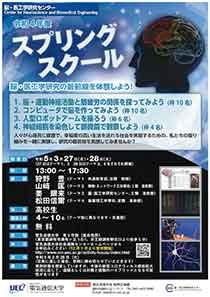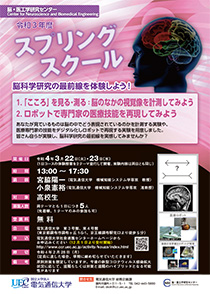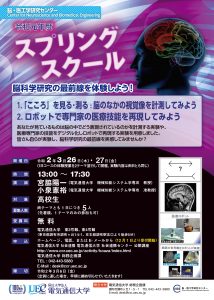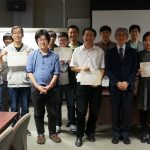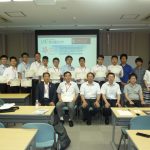CNBE Spring School for High School Students 2025
2024.10.9
CNBE Spring School for High School Students 2025 will be held from March 26th to 27th, 2025. Through the experimental lectures that will be conducted and experienced by themselves, participants will learn about the cutting edge of neuroscience and biomedical engineering.
(All of the following will be conducted in Japanese.)
Topic 1: Manipulate a Humanoid Robot Arm.
Topic 2: Make luminescent materials for firefly bioluminescence system and visualize biological tissue specimens.
Topic 3: Replicate the diagnostic and therapeutic skills of medical professionals using robots!
Topic 4: Let’s build a brain with a computer.
Please apply from this link. (Registration starts on December 2nd, 2024.)”
CNBE Spring School for High School Students 2024
2024.3.26-27
CNBE Spring School for High School Students 2024 was held from March 26th to 27th, 2024. Participants were able to experience the results of cutting-edge research in neuroscience and biomedical engineering through hands-on, experimental lectures.
Topic 1: Let’s measure gene expression using real-time PCR.
Topic 2: Using a laser microscope to capture three-dimensional images.
Topic 3: Creating Visual AI Models.
Topic 4: Manipulate a Humanoid Robot Arm.
Exhibit at MEDTEC Japan 2023
Research results of CNBE will be exhibited at MEDTEC Japan 2023.
Period: April 19 (Wed.) – 21 (Fri.), 2022, 10:00 – 17:00
Place: Tokyo Big Sight, East Hall, Booth #205
Contents: Research and development of medical engineering technology to support a super-aging society. In particular, we propose medical and welfare technologies to overcome brain and muscle diseases and support recovery from pathological conditions, as well as detection of unwellness and ubiquitous healthcare systems based on non-contact biomedical measurement and large-scale analysis technologies.
How to participate: Please pre-register (free of charge) at the organizer’s Web page and visit the exhibition booth at Tokyo Big Sight.
https://www.medtecjapanreg.com/2023/form.cgi?lang=ja
CNBE Spring School for High School Students 2023
CNBE Spring School for High School Students 2023 was held for Mar. 27th to 28th, 2023. Through the experimental lectures which will be conducted and experienced yourselves, you will learn the edge of neuroscience and biomedical engineering.
Topic 1: Explore the relationship between brain/motor nerve activity and muscle fatigue.
Topic 2: Let’s build a brain using a computer.
Topic 3: Manipulate a Humanoid Robot Arm.
Topic 4: Staining Neurons for Microscopic Observation.
Please apply from this link.
Exhibit at MEDTEC Japan 2022
Research results of CNBE will be exhibited at MEDTEC Japan 2022.
Period: April 20 (Wed.) – 22 (Fri.), 2022, 10:00 – 17:00
Place: Tokyo Big Sight, East Hall 3, Booth #1000
Contents: Introduction of research and development trends by the Center for Neuroscience and Biomedical Engineering (CNBE), focusing on exhibits and demonstrations of ultrasonic biomonitoring (20th), non-contact vital measurement systems (21st), and five-fingered myoelectric prosthetic hands (22nd), etc.
How to participate: Please pre-register (free of charge) at the organizer’s Web page and visit the exhibition booth at Tokyo Big Sight.
https://www.medtecjapanreg.com/2022/form.cgi?lang=ja
CNBE Spring School for High School Students 2022
CNBE Spring School for High School Students 2022 was held for Mar. 22nd to 23rd, 2022. Through the experimental lectures which will be conducted and experienced yourselves, you will learn the edge of neuroscience and biomedical engineering.
Topic 1: Watch and measure your “mind”; let’s measure the visual images in your brain.
Topic 2: Let’s reenact the medical skills of professionals by a robot.
Please apply from this link.
CNBE Symposium 2021
CNBE Symposium 2021
R-3 Results briefing (on-site and online live streaming)
Part 1 Group in creation of fundfamental technology
Place: Oct. 18th (Sun.) 13:00 – 16:10, E5-241
Special talk: Prof. Hidenori Sakanashi (AIST)
Results talk: Shono lab., Maki Lab., Nakamura Lab., Tokurakawa Lab.
Part 2 Group in measurement and control of brain
Time and Place: Nov. 8th (Sun.) 14:00 – 17:10, E5-241
Special talk: Prof. Masanori Murayama (RIKEN CBS), Chair: Prof. Yoshihisa Kudo
Results talk: Miyawaki lab., Matsuda lab., Masamoto lab., Ando lab.
Part 3 Group in analysis and control of movement
Time and Place: Nov. 16th (Mon.) 13:00 – 16:10 B-202
Special talk: Prof. Hideaki Soya (Tsukuba Univ.)
Results talk: Kano lab., Okada lab., Togo lab., Ohkawara lab., Hoshino lab.
Part 4 Group in medical and welfare technology
Time and Place: Dec. 2 (Thu.) 13:00 – 16:30
Special talk: Prof. Ichiro Sakuma (Tokyo Univ.) (Planned)
Results talk: Koike lab., Yokoi lab., Koizumi lab., Sun lab., Jiang lab.
Part 5 Group in theoretical neuroscience
Time and Place: Dec. 24 (Fri.) 15:00 – 18:00, B-202
Special talk: Prof. Tomoki Fukai (OIST)
Results talk: Kashimori lab., Tanaka lab., Sato lab., Yamazaki lab.
CNBE Spring School for High School Students 2020
CNBE Spring School for High School Students 2020 will be held for Mar. 26th to 27th, 2020. Through the experimental lectures which will be conducted and experienced yourselves, you will learn the edge of neuroscience and biomedical engineering.
Topic 1: Watch and measure your “mind”; let’s measure the visual images in your brain.
Topic 2: Let’s reenact the medical skills of professionals by a robot.
Please apply from this link (Extension Lectures, Center for Community Relations, UEC Tokyo).
BLSC Spring School for High School Students 2019
 2019/03/27-2018/03/28
2019/03/27-2018/03/28
BLSC Spring School for High School Students 2019 was held from Mar. 27th to 28th, 2019. Participants conducted experiments themselves to experience the frontiers of brain science and its applications.
Topic 1: Let’s make an image processing AI mimicking brain functions. (Text) (Presentation)
Topic 2: Let’s look human motions with a motion capture technique. (Text) (Presentation)
UEC-BLSC-Spring School 2019 Poster
Technology Training Course on Surface EMG Measurement and Myoelectric Prosthetic Hand Control (Sakura Science Program 2018)
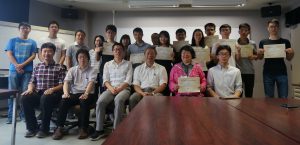 2018.5.28 – 6.6
2018.5.28 – 6.6
Supported by SAKURA Exchange Program in Science of JST, ten graduate students and one teacher of Nankai University, China, were invited to the Brain Science Inspired Life Support Research Center of UEC to participate in the technology training course on surface EMG measurement and myoelectric prosthetic hand control.
Detailed report of the program (in Japanese)
BLSC Spring School for High School Students 2018
 2018/03/28-2018/03/29
2018/03/28-2018/03/29
BLSC Spring School for High School Students 2018 was held from Mar. 28th to 29th, 2018. Participants conducted experiments themselves to experience the frontiers of brain science and its applications.
Topic 1: Reconstruction of brain functions by supercomputers. (text)(slides) (linked URL including programming codes)
Collaborative Research on Control of Healthcare Robots Based on Biological Signals (Sakura Science Program 2017)
2017/09/27-10/07
The collaborative research program sponsored by the Sakura Science Program was conducted from September 27, 2017, to October 7, 2017. The program invited ten students and one attendant professor from the Department of electrical engineering, Shenyang University of Technology, China, to Brain Science Inspired Life Support Research Center, the University of Electro-Communications. Chinese participants conducted experiments on the control of healthcare robots based on biological signals, visited several research centers in Japan, and attended the report meeting and graduation ceremony. The program was highly appreciated by all participants, and facilitated mutual understanding between the participants from both China and Japan.
Detailed report of the program (in Japanese)
UEC-ERATO Syposium
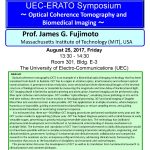
Date and time: Fri. Aug. 25, 2017, 13:30-14:30
“Seminar on OCT (Optical Coherence Tomography)”
Place: Room 301, Building E-3, UEC
Speaker: Prof. James G. Fujimoto (MIT, USA) (Very famous professor as an inventor of OCT that is a non-invasive medical imaging used clinically in ophthalmology.)
Title:Optical Coherence Tomography and Biomedical Imaging
Sponsored by Minoshima Intelligent Synthesizer Project, ERATO, JST.
Cosponsored by Center for Photonic Innovation, and BLSC (Brain Science Inspired Life Support Research Center), UEC.
Experiences of Science and Technology on Robotics — From Fundamentals to Applications (Sakura Science Program 2017)
2017/07/15-07/22
The research exchange program sponsored by the Sakura Science Program, this year, aims to provide opportunities to foreign students to experience science and technology in the field of robotics in Japan. The program invited ten students and one attendant professor from the Department of mechanical and power engineering, Shanghai Jiaotong University, China, to the Graduate School of Informatics and Engineering and Brain Science Inspired Life Support Research Center, the University of Electro-Communications. Chinese participants visited several famous research centers of the governmental research institutes, universities and industries, and discussed with the researchers. They also enjoyed Japanese science and technology as well as nature and culture of Japan. The program was highly appreciated by all participants, and seemed to facilitate mutual understanding between China and Japan. It is expected that experience and mutual understanding obtained from this program will become a solid basis of a future development of research collaboration.
Detailed report of the program (in Japanese)
Campus Tour at Homecoming Day 2017
 2017/07/16
2017/07/16
BLSC participates in the Campus Tour at Homecoming Day 2017 2017HomeComingDay. Prof. Yokoi’s laboratory introduces its activities on development of medical and healthcare devices.
BLSC Special Lectures at 1st Open Campus in 2017
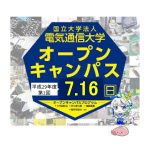
2017/07/16
Program of BLSC Special Lectures at Open Campus in 2017
Open Campus-BLSC Special Lecture by Prof. S. Tanaka
Open Campus-BLSC Special Lecture by Prof. Y. Miyawaki
Open Campus-BLSC Special Lecture by Prof. T. Koike
Open Campus-BLSC Special Lecture by Prof. S. Matsuda
BLSC Spring School for High School Students 2017
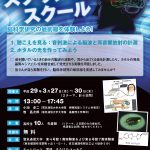 2017/03/27-2017/03/30
2017/03/27-2017/03/30
BLSC Spring School for High School Students 2017 was held from Mar. 27th to 30th, 2017. Participants conducted experiments themselves to experience the frontiers of brain science and its applications to life support technology.
BLSC Spring School for High School Students 2016
 2016/03/28-2016/03/31
2016/03/28-2016/03/31
BLSC Spring School for High School Students 2016 was held from Mar. 28 to 31, 2016. All participants conducted experiments themselves to experience the frontiers of brain science and its applications to life support technology.
Topic 1: Laser microscopy (Text)
Topic 2: Cyborg artificial hand (Text)
Video of the BLSC Spring School 2016 (Video UEC-TV News)
Video of the BLSC Spring School 2016(YouTube)
Report of the BLSC Spring School 2016
Research Exchange Program through Life Support Technologies Based on Electrophysiology (Sakura Science Program 2015)
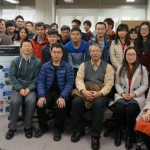
2016/02/26-03/06
The research exchange program sponsored by the Sakura Science Program aims to promote collaborative research projects in the field of life support technologies. In the program, the participants were divided into two groups for hands-on experiments, one for manufacturing bio-electric controlled prosthetic hands and the other for measuring brain activities related to functional electric stimulation, and each group experienced hands-on learning. Sixteen students worked for the program. Chinese participants enjoyed Japanese science and technology as well as nature and culture of Japan. The program was highly appreciated by all participants, and seemed to facilitate mutual understanding between China and Japan. It is expected that experience and mutual understanding obtained from this program will become a solid basis of a future development of research collaboration.
Research Exchange Program through Life Support Technologies Based on Electrophysiology
Object Vision in Human, Monkey, and Machine
 2015/11/05
2015/11/05
International symposium titled “Object Vision in Human, Monkey, and Machine” was held in The University of Electro-Communications from 5th to 6th, November, 2015. Recent results of research topics on object vision in human, monkey and machine were presented and many discussions were made among the participants.
Practical Implementation of Developed Medical Devices in the Field of Life Support Technology
Symposium “Practical Implementation of Developed Medical Devices in the Field of Life Support Technology”
 Japan Manufacturing Commons for Collaboration of Medicine and Engineering
Japan Manufacturing Commons for Collaboration of Medicine and Engineering
http://www.ikou-commons.com/
An article of the message from Dr. H. Kubota, K and K Japan, Co. Ltd., was published on the occasion of participating the symposium “Practical Implementation of Developed Medical devices in the Field of Life Support Technology.”
【Nikkei Digital Health】”Collaboration between Medicine and Engineering at a university without a school of medicine”
Poster of Technical Meeting
Technical Meeting “Data Driven Approach for Understanding the Cerebellar Central Nerve System Which Controls Eye Movements”
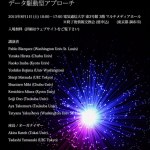 Co-sponsored by Japanese Neural Network Society and BLSC, UEC
Co-sponsored by Japanese Neural Network Society and BLSC, UEC
2015/08/01
Technical Meeting
http://numericalbrain.org/jnnsjigen/
SPECIAL INVITED TALKS AND EXCHANGE LECTURES
In cooperation with “the Technical English Course of the Department of Mechanical Engineering and Intelligent Systems” and BLSC, UEC
| Date and time: | Thu. Jul. 2, 2015, 16:15 – 17:45 |
|---|---|
| Place: | Practice room, Information Technology Center, UEC |
| Chair: | Prof. Hiroshi Yokoi |
| Talk/Lecture #1 | |
| Speaker: | Dr. Qixin CAO (Professor, Director, Engineering Training Center, Shanghai Jiao Tong University) |
| Title: | Robotics and Digital Factory |
| Abstract: | Robotic industrial is considered one of the most promising industries in the future. In the last 5 years, the global industrial robot sales increased at the rate of 9% for each year. While in China, the annual increasing rate is as high as 25%. It is generally believed that the Chinese industrial robot market will continue to grow explosively in the next 5-10 years. The ear of Industry 4.0 “smart factory and smart manufacturing” provides new development space for the industrial robots. This study explores the intelligent, modularized and systematic development trend of industrial robots. It is anticipated that the market which is dominated by the large enterprises such as Yasukawa, KUKA, ABB and Fanuc will be changed by the development of modular, intelligence and network technology. The small and medium-sized enterprises will play bigger roles in the future robotic industry. In the end, our preliminary research demonstrates it is feasible to use modularization to improve the robot development. |
| Talk/Lecture #2 | |
| Speaker: | Dr. Weidong CHEN (Professor, Department of Automation, School of Electronic, Information and Electrical Engineering, Shanghai Jiao Tong University) |
| Title: | Improving Safety and Autonomy of intelligent Wheelchair in Dynamic Environments |
| Abstract: | Recently, China faces social problems caused by a sharp increase in its aging population, and there is increasing demand for assistive devices and technologies in home and office environments to effectively help improving the quality of the lives of the elderly or disabled. Intelligent wheelchair is a typical mobility assistive robot designed to assist a user with a physical disability or cognitive impairments. Intelligent wheelchairs are interacting closely with humans and performing navigation tasks in human environments with unpredictable changes, the autonomy and safety issues are more essential for these complex and challenging situations. In this talk, I will introduce our recent work on intelligent wheelchair with emphasis on autonomy and human-safety in the aspects of mapping, localization, navigation and human-robot interaction. The prototype systems of intelligent wheelchair developed in our lab, as well as experimental studies in real and dynamic environments will be presented for illustrating our methodologies and applications. |
BLSC KICK-OFF MEETING
For more information, click here: HANDS-ON TRAINING
BLSC KICK-OFF MEETING
Date and Time: May 14 (Tue.), 2013, 13:00~18:00
Venue: Meeting room #301, Building E-3, UEC
Program
| Speaker | Affiliation | Title |
|---|---|---|
| Prof. Makoto Kajitani | President of UEC | Opening address |
| Prof. Kazuo Tanishita | Waseda University | Biomechanics of hemodynamics in brain |
| Prof. Ichiro Sakuma | The University of Tokyo | Subjects toward success of collaborative research between medicine and engineering |
| Prof. Shojiro Maki | BLSC, UEC | Development and application of materials emitting bioluminescence by firefly in the near infrared wavelength range |
| Prof. Yutaka Kano | BLSC, UEC | Evaluation of muscle performances by bio-imaging and its application |
| Prof. Shigeru Tanaka | BLSC, UEC | Study of working memory toward the elucidation of human thinking processes |
| Prof. Hiroshi Yokoi | BLSC, UEC | R&D for recovery of motion performances using brain-machine-interface (BMI) |
| Prof. Makoto Shimojo | Director of BLSC, UEC | Closing remarks |



